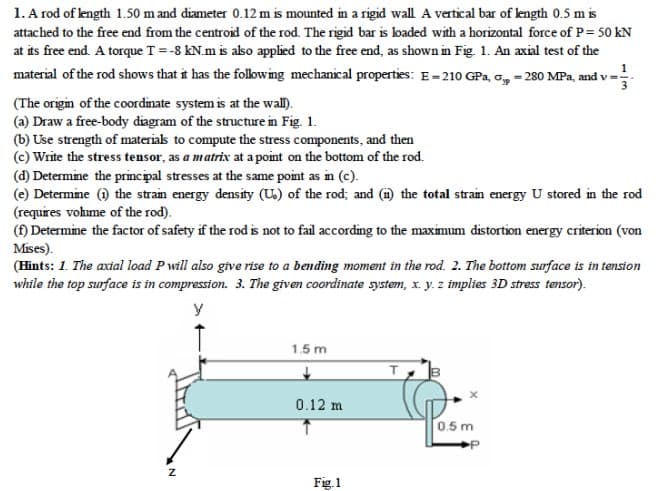1. A rod of length 1.50 m and diameter 0.12 m is mounted in a rigid wall A vertical bar of length 0.5 m is attached to the free end from the centroid of the rod. The rigid bar is loaded with a horizontal force of P= 50 kN at its free end. A torque T = -8 kN.m is also applied to the free end, as shown in Fig. 1. An axial test of the material of the rod shows that it has the following mechanical properties: E-210 GPa, o, - 280 MPa, and v=- (The origin of the coordinate system is at the wall). (a) Draw a free-body diagram of the structure in Fig. 1. (b) Use strength of materials to compute the stress components, and then (c) Write the stress tensor, as a matrix at a point on the bottom of the rod. (d) Determine the principal stresses at the same point as in (c). (e) Determine () the strain energy density (U.) of the rod; and () the total strain energy U stored in the rod requires vohume of the rod). (f) Determine the factor of safety if the rod is not to fail according to the maximum distortion energy criterion (von
1. A rod of length 1.50 m and diameter 0.12 m is mounted in a rigid wall A vertical bar of length 0.5 m is attached to the free end from the centroid of the rod. The rigid bar is loaded with a horizontal force of P= 50 kN at its free end. A torque T = -8 kN.m is also applied to the free end, as shown in Fig. 1. An axial test of the material of the rod shows that it has the following mechanical properties: E-210 GPa, o, - 280 MPa, and v=- (The origin of the coordinate system is at the wall). (a) Draw a free-body diagram of the structure in Fig. 1. (b) Use strength of materials to compute the stress components, and then (c) Write the stress tensor, as a matrix at a point on the bottom of the rod. (d) Determine the principal stresses at the same point as in (c). (e) Determine () the strain energy density (U.) of the rod; and () the total strain energy U stored in the rod requires vohume of the rod). (f) Determine the factor of safety if the rod is not to fail according to the maximum distortion energy criterion (von
Elements Of Electromagnetics
7th Edition
ISBN:9780190698614
Author:Sadiku, Matthew N. O.
Publisher:Sadiku, Matthew N. O.
ChapterMA: Math Assessment
Section: Chapter Questions
Problem 1.1MA
Related questions
Question
Parts d, e and f

Transcribed Image Text:1. A rod of length 1.50 m and diameter 0.12 m is mounted in a rigid wall A vertical bar of length 0.5 m is
attached to the free end from the centroid of the rod. The rigid bar is loaded with a horizontal force of P= 50 kN
at its free end. A torque T =-8 kN.m is also applied to the free end, as shown in Fig. 1. An axial test of the
material of the rod shows that it has the following mechanical properties: E=210 GPa, a, = 280 MPa, and v =:
(The origin of the coordinate system is at the wall).
(a) Draw a free-body diagram of the structure in Fig. 1.
(b) Use strength of materials to compute the stress components, and then
(c) Write the stress tensor, as a matrix at a point on the bottom of the rod.
(d) Determine the principal stresses at the same point as in (c).
(e) Determine () the strain energy density (U.) of the rod; and (î) the total strain energy U stored in the rod
(requires vohme of the rod).
(f) Determine the factor of safety if the rod is not to fail according to the maximum distortion energy criterion (von
Mises).
(Hints: 1. The axial load P will also give rise to a bending moment in the rod. 2. The bottom surface is in tension
while the top surface is in compression. 3. The given coordinate system, x. y. z implies 3D stress tensor).
y
1.5 m
0.12 m
0.5 m
Fig. 1
Expert Solution
This question has been solved!
Explore an expertly crafted, step-by-step solution for a thorough understanding of key concepts.
This is a popular solution!
Trending now
This is a popular solution!
Step by step
Solved in 5 steps

Knowledge Booster
Learn more about
Need a deep-dive on the concept behind this application? Look no further. Learn more about this topic, mechanical-engineering and related others by exploring similar questions and additional content below.Recommended textbooks for you

Elements Of Electromagnetics
Mechanical Engineering
ISBN:
9780190698614
Author:
Sadiku, Matthew N. O.
Publisher:
Oxford University Press

Mechanics of Materials (10th Edition)
Mechanical Engineering
ISBN:
9780134319650
Author:
Russell C. Hibbeler
Publisher:
PEARSON

Thermodynamics: An Engineering Approach
Mechanical Engineering
ISBN:
9781259822674
Author:
Yunus A. Cengel Dr., Michael A. Boles
Publisher:
McGraw-Hill Education

Elements Of Electromagnetics
Mechanical Engineering
ISBN:
9780190698614
Author:
Sadiku, Matthew N. O.
Publisher:
Oxford University Press

Mechanics of Materials (10th Edition)
Mechanical Engineering
ISBN:
9780134319650
Author:
Russell C. Hibbeler
Publisher:
PEARSON

Thermodynamics: An Engineering Approach
Mechanical Engineering
ISBN:
9781259822674
Author:
Yunus A. Cengel Dr., Michael A. Boles
Publisher:
McGraw-Hill Education

Control Systems Engineering
Mechanical Engineering
ISBN:
9781118170519
Author:
Norman S. Nise
Publisher:
WILEY

Mechanics of Materials (MindTap Course List)
Mechanical Engineering
ISBN:
9781337093347
Author:
Barry J. Goodno, James M. Gere
Publisher:
Cengage Learning

Engineering Mechanics: Statics
Mechanical Engineering
ISBN:
9781118807330
Author:
James L. Meriam, L. G. Kraige, J. N. Bolton
Publisher:
WILEY